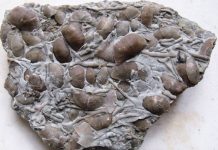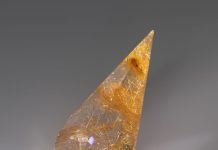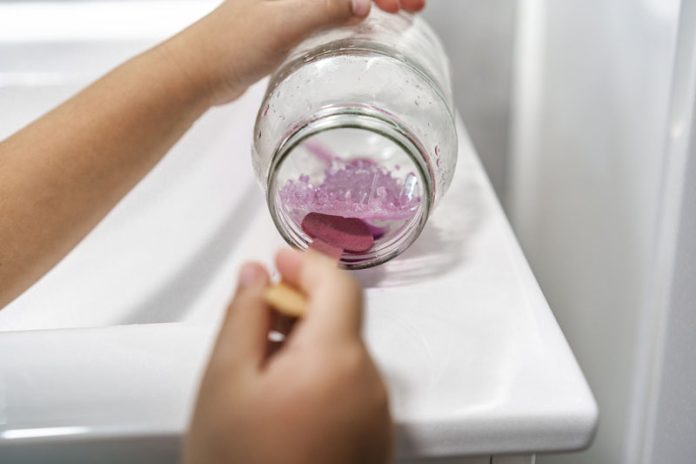
Simple geology activities can make learning about what makes up the rocks beneath our feet fun. Try these easy home experiments to learn more about geology and the rocks all around you!
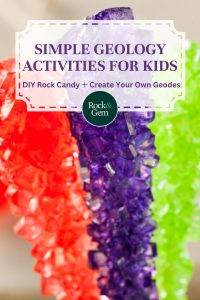
The Fizz Test
If you’ve got a rock you can’t identify, a test for calcium carbonate can help narrow down the list of possibilities. The easiest test for the presence of calcium carbonate is to apply acid to a rock. When the acid comes in contact with the calcium carbonate, the resulting chemical reaction releases carbon dioxide, which causes a bubbling, fizzing action on the surface of the rock.
Experts use hydrochloric acid, but this strong acid can be unsafe. A much safer option is white vinegar. The easiest method is to soak a stone in vinegar.
Place the specimen in a glass bowl or mason jar and pour in enough vinegar to cover the stone. Depending on the amount of calcium carbonate in the stone, it might react immediately, or it could take several minutes. The reaction is obvious. If you see bubbles, the stone contains calcium carbonate. A good way to expand on this test is to use several rock specimens. There might be a few surprises and it’s worth looking into why calcium carbonate is, or is not, present.
For Chemistry Students
This is a terrific chemistry problem because everyone loves balancing equations, right? To give you a sneak peek, here’s how it looks on the chemical level combining the calcium carbonate with acetic acid (vinegar): CaCO3+ 2CH3COOH = Ca(CH3COO)2 + H2O + CO2. It’s the carbon dioxide that gives it the effervescence.
Around the House
Limestone is a classic example of calcium carbonate as it’s formed when the mineral settles in bodies of water, but it’s also present in marble which is why you don’t want to clean marble with acidic products.
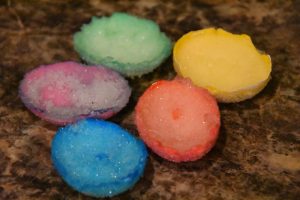
Make Eggshell Geodes
Who doesn’t love to create geodes?! They’re fun and exceptionally pretty. They’re also a lesson in crystallization and solubility. Because this experiment calls for boiling water, adult supervision is recommended.
For this project, use three eggs and crack them lengthways to provide the most surface area. Put the yolk and whites in a separate container and refrigerate to use later. Use hot water to wash the inside of the egg and gently peel away the inner eggshell membrane to prevent it from spoiling and ruining the crystals.
In a quart-sized pan, boil four cups of water. Stir in one and three-quarters to two cups of borax (sodium borate) into the solution and stir constantly, while still on the heat, until the borax mostly dissolves. There should be a little left on the bottom after everything else is incorporated into the solution. This is called a supersaturated solution. Remove from the heat and allow to cool for 10 minutes.
Pour approximately three-quarters of a cup of the hot solution into five glass bowls or pint mason jars and add a couple of drops of food coloring to each one. Place the eggshell halves into the solution (one might have to have two in one bowl) and set these somewhere they won’t be disturbed. After a day or two, you’ll notice the borax crystals forming all around the eggshell. Remove from the bowl after the desired amount of crystals have formed. Store in a cool, dry place away from sunlight.
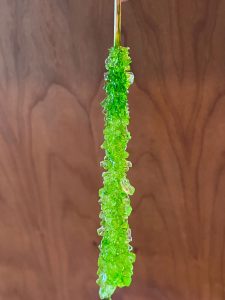
Make Tasty Rock Candy
Explore crystal formation by making old-fashioned rock candy. Yum! This involves a super-saturated solution where the sugar crystals settle out and cling to a skewer as the water cools and evaporates. (Adult help is needed for younger kids.)
Start by gathering your ingredients.
• Bamboo skewers or wooden chopsticks
• Clothespins
• Quart-sized narrow-mouth Mason jars
• 4 cups of filtered water
• 2 cups of granulated sugar
• Food coloring and flavoring are optional
Start by dampening each skewer and rolling it on a plate with sugar to give it a base for the crystals to form. For each jar, use a clothespin to vertically hold the skewer upright in the jar.
Bring the water to a gentle boil and begin adding sugar, constantly stirring until no more sugar dissolves. There will be a little sugar left at the bottom of the pan. Add food color and flavor if desired and pour into the jars with the skewers. It will take five to seven days for the candy to form. Study the crystals and then eat your creations.
Have fun!
This story about simple geology activities for kids previously appeared in Rock & Gem magazine. Click here to subscribe. Story by Amy Grisak.


